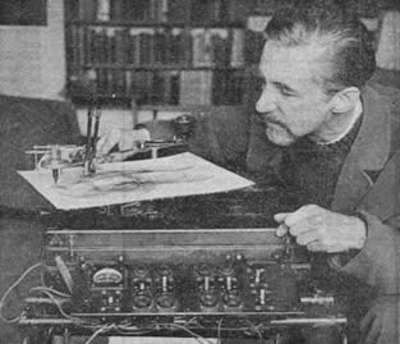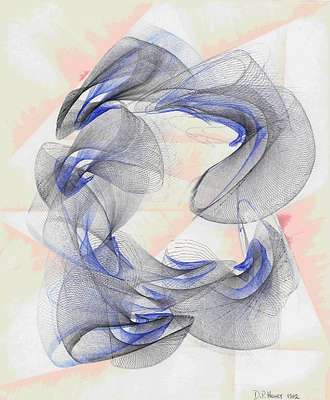“Following service in the Second World War as a technical clerk in the Royal Electrical and Mechanical Engineers, Desmond Paul Henry took a degree in Philosophy at the University of Leeds. He went on to teach at the University of Manchester, where he remained until his retirement in 1982.
Henry had attended evening art classes prior to the war, and remained fascinated by both art and technology. In the early 1950s he purchased a remaindered Analogue Bombsight, a machine previously used by fighter pilots for accurate bombing of targets. Henry adapted this device to create a drawing machine. His first exhibition of machine-made drawings was at the Reid Gallery in London, in 1962, and it brought Henry and his machines considerable publicity.
Henry continued to create and experiment with new drawing machines throughout his life, and in 2002 Henry developed his fifth drawing machine, based around a pendulum design.” [V&A, n. d.]
Desmond Paul Henry
| i |



| last name: | Henry |
| first name: | Desmond Paul |
| birthday: | 1921 |
| death date: | 2004 |
Summary
Biography
| 1946-49 | Drawings exhibited in student art shows while a student at Leeds University. |
| 1949-82 | Pictures exhibited in staff art shows while a lecturer and reader in Philosophy at Manchester University. |
| 1955 | Ink drawing exhibited at Manchester City Art Gallery as part of exhibition entitled: Artists with North Country Associations. |
| 1961 | Henry became the winner of a local art competition called London Opportunity organised by Salford Art Gallery. One of the judges for the prize was artist L.S. Lowry, who visited Henry’s home. The picture which won this competition used, as its first stage for inspiration, effects produced using Henry’s unique photochemical technique. |
| 1962 | Henry’s one-man prize-show called Ideographs, held at the Reid Gallery in London’s West End. Here Henry exhibited watercolours, graphics on photo-paper and for the first time, “machine-drawings”. One-man exhibition of machine drawings held at Salford Art Gallery and claimed by Henry to be ‘the world’s first one-machine show’. Interviewed on the BBC’s first programme in the “North at Six” series. Discussed and demonstrated his first drawing-machine. Crumpsall Library: one-man exhibition of machine-drawings. |
| 1963 | Henry was interviewed by George Will to be featured in LIFE Magazine. Article scrapped following the assassination of U.S President J. F. Kennedy. |
| 1964 | One-man show of machine-produced drawings at Central Library, Manchester. |
| 1965 | A performance of creative dance based around the stimuli of Henry’s ‘computer-drawn’ pictures was held at the Mather College, Manchester. Exhibited, together with other artists including L.S. Lowry, at the Frape Memorial Exhibition (Frape was the former director of Salford Art Gallery who died in Nov. 1963). |
| 1968 | Drawing Machine Two together with its machine-generated images exhibited at the I.C.A.’s Cybernetic Serendipity exhibition (London). This was a major Computer Art show of the 1960’s. This second machine went on tour with this exhibition around the U.S.A., from which it returned completely damaged in 1972. |
| 1976 | Exhibited drawings produced by Drawing Machine Three at Manchester Evening News premises in an exhibition called North West Artists. |
| 1990 | Henry given pioneer status in the Cambridge Encyclopedia of 1990 under the entry ‘Computer Art’. |
| 2010 | Kinetica Art Fair, London: Henry exhibited four originals in the Cybernetic Serendipity feature section of this exhibition. Daughter Elaine O’Hanrahan gave a talk on her father’s work as an early British Computer Art pioneer. |
| 2011 | Desmond Paul Henry exhibition opens at the Museum of Science and Industry, Manchester. The exhibition entitiled Desmond Paul Henry; Manchester Pioneer of Computer Art is referenced by the New York Times and the BBC. |
Exhibitions
Illustrations
Comments
enter new comment



